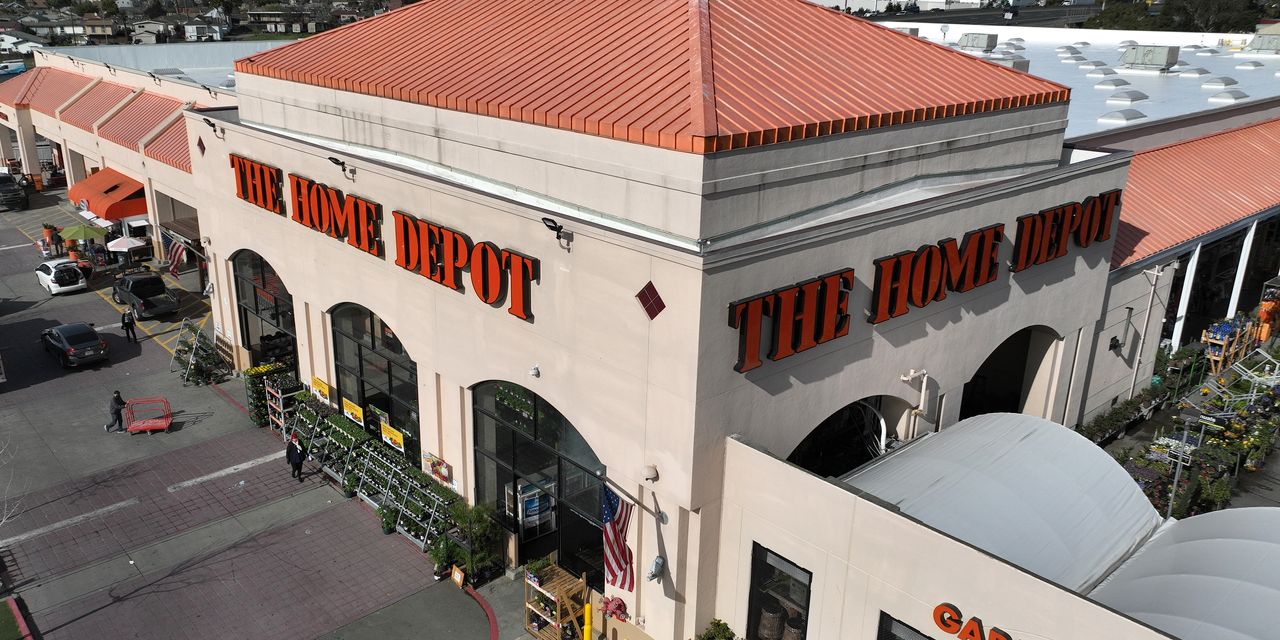It isn’t just the weather. Consumers are pulling back from home improvement.
Softening customer demand has pushed
Home Depot
to slash its outlook for the fiscal year, a move that has sent shares in the home-improvement retailer tumbling and knocked the
Dow Jones Industrial Average
lower.
Home Depot (ticker: HD) reported earnings of $3.82 a share in the first three months of the year, slightly ahead of the $3.80 expected by analysts surveyed by FactSet. But quarterly sales of $37.8 billion were short of estimates of $38.3 billion, which the company blamed on declining lumber prices and unfavorable weather.
It got worse with the financial forecasts. Home Depot is now projecting sales will fall 2% to 5% from 2022, while it said in February that yearly sales should be flat year over year. It also cut earnings-per-share guidance, saying they are likely to slide 7% to 13% on an annual basis, compared with a previous call for a decline in the mid single digits.
“Given the negative impact to first-quarter sales from lumber deflation and weather, further softening of demand relative to our expectations, and continued uncertainty regarding consumer demand, we are updating our guidance to reflect a range of potential outcomes,” said Richard McPhail, Home Depot’s chief financial officer.
Barron’s noted previously that lower lumber prices, which had spiked during the pandemic, were likely to weigh on same-store sales. Nonetheless, the 4.5% tumble in comparable sales was worse than the 1.6% fall analysts expected. It represents the largest quarterly decline in more than a decade, reflecting both lumber prices and lower demand.
The company’s decision to cut its fiscal 2023 forecast so early in the year may be prudent, but it has also spooked investors who were hoping—too optimistically—that more recent trends would show consumers had simply postponed home-improvement projects during a wet and stormy spring. The more-conservative outlook implies that isn’t happening.
“We believe investors were bracing for a weaker first-quarter print, but also indications of rebounding trends into mid-May,” wrote MKM Roth analyst David Bellinger. “This morning’s full-year guide down indicates to us that any acceleration second quarter-to-date has not been enough to instill confidence into the back half amid ‘broad-based pressures’ across the business.”
Shares of Home Depot, a component of the Dow, slipped 1.5% to $284.37 in early trading, while the market benchmark was down 0.5%. Home Depot stock had shed nearly 9% this year as of Monday’s close.
Therefore Mother Nature isn’t entirely to blame, but isn’t helping either. Weather has been a major factor complicating business for the home-improvement industry, which already was navigating a slowing economy macroeconomic turbulence now being made worse by unseasonably cold conditions. Warmer weather helps spur both do-it-yourself and professional construction projects.
Weather has been a thorn in the side of similar companies, including
Tractor Supply
(TSCO) and
Sherwin-Williams
(SHW). Tractor Supply said poor weather caused a two-percentage-point decline in comparable-store sales. Its core business leans more toward agriculture—an area even more weather-dependent than home improvement—but the company’s results are often a “decent read through” for companies such as Home Depot and
Lowe’s
(LOW), said Raymond James analyst Bobby Griffin.
Lowe’s stock dropped 1.9% in early trading. “We expect Lowe’s will see a similar headwind from lumber deflation as Home Depot,” said Jonathan Matuszewski, an analyst at Jefferies.
Weather aside, Home Depot also faces some challenges from the housing market, which has been in a bit of a slump over the past few quarters as rising interest and mortgage rates hinder demand. As Barron’s has reported, the spring home-buying season, which is typically one of the busiest, has been slower than usual this year.
Home-improvement retailers can still benefit when people aren’t in the market for a new home. The concern for investors is that worry about a recession, along the cost of financing big-ticket remodeling plans, has also discouraged people from undertaking renovation projects.
Indeed, the results demonstrate that consumers are feeling pinched. On its conference call, Home Depot noted that business from both do-it-yourself and professionals were down in the quarter, with shoppers shying away from expensive discretionary purchases. In addition, while Pros still have elevated backlogs relative to history, those backlogs have shrunk since last year, and their projects are shifting away from big remodels to more modest upgrades.
Gross margins were also lower in the quarter, hurt by “shrink,” an industry term for inventory loss, including shoplifting, which plenty of other retailers have also cited as a headwind in recent months.
Nevertheless, management is upbeat. “While the near-term environment is uncertain, we remain very positive on the medium-to-long term outlook for home improvement and our ability to grow share in a large and fragmented market,” said Ted Decker, Home Depot’s chairman and CEO.
Write to Jack Denton at [email protected], Teresa Rivas at [email protected], and Sabrina Escobar at [email protected]
Read the full article here


